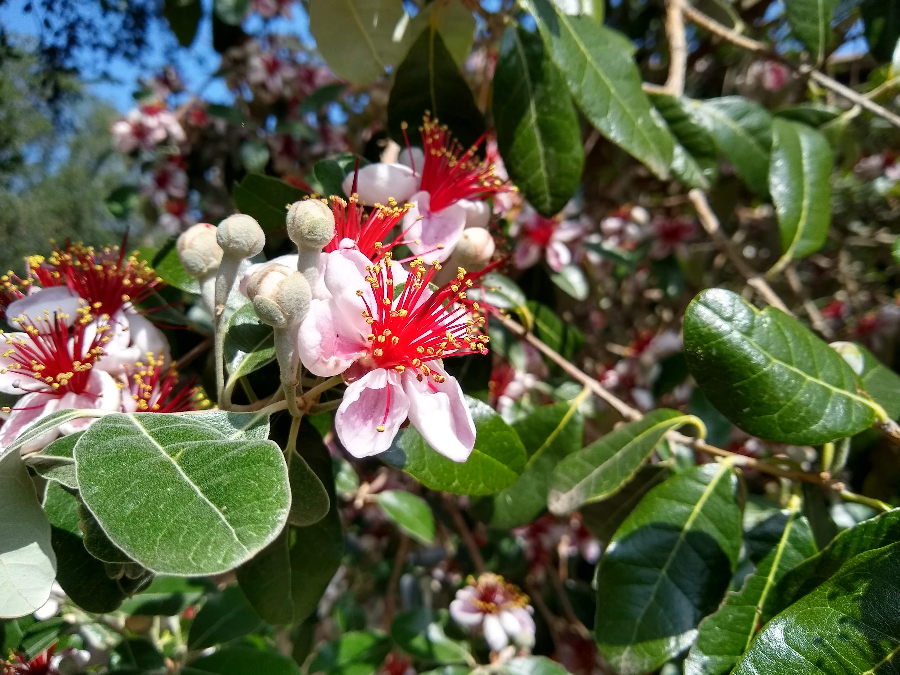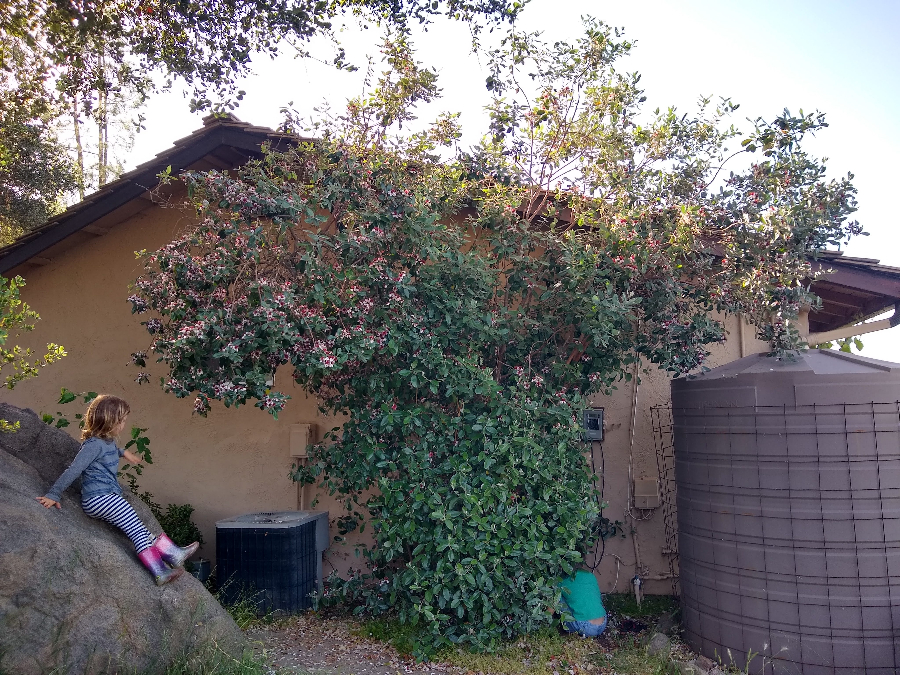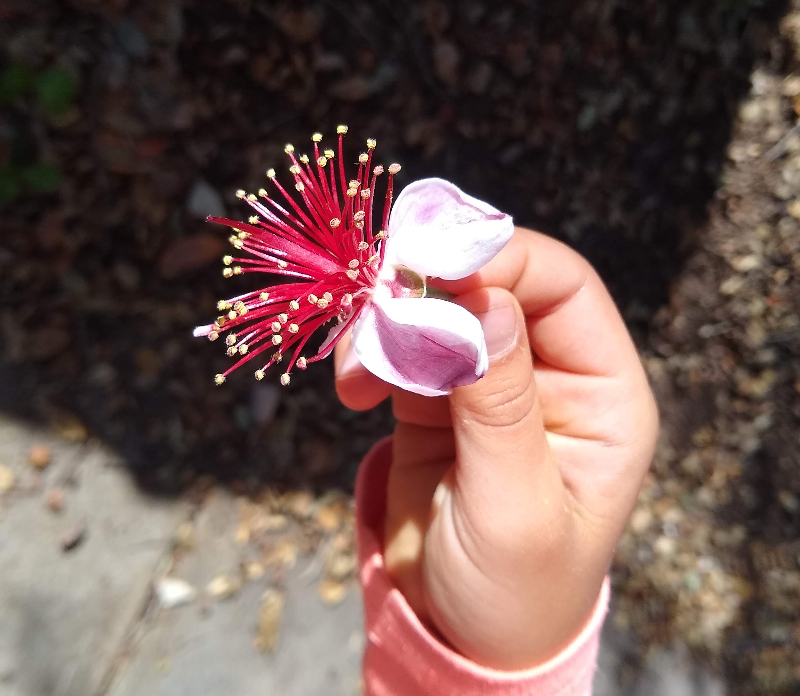This week I was in the kitchen while my three kids were at the dining room table and I overheard this conversation.
Miles (six years old): “There are lots of edible flowers, like pineapple guava, broccoli . . .”
Reeve (four years old): “Broccoli is not a flower.”
Cass (eight years old): “It is. You know all the little balls on top? Those are flower buds.”
Reeve: “Still don’t believe you.”
Miles: (calls to me) “Dad?! Reeve doesn’t believe that broccoli is a flower!”
Regardless of Reeve’s beliefs about broccoli, she is just like her brothers in that she cannot pass by the pineapple guava tree without stopping to feast on its flowers.
Here in early May there are still enough that they can reach from the ground or by climbing up on a nearby boulder, but each spring at some point I park a ladder by the tree and they argue over whose turn it is to climb the ladder to pick the high flowers.
Did you know that the flowers of pineapple guava were not only edible but sweet and tasty, with a tropical flavor and a melon-like texture? Lots of flowers are edible: nasturtium, bougainvillea, squash, etc. But the flowers of pineapple guava are flowers that you actually want to eat — fresh, straight off the plant.
If you know how to pick them, then you look for ones with petals that are thick. You can eat them straight off the flower or pull off individual petals and pop them in your mouth. But it’s hard not to squish the delicate petals if you choose that method. Then again, eating the petals right off the flower results in your face being dabbed with yellow pollen from the protruding stamens. The price you pay.
Are you familiar with pineapple guava? Its botanical name is Feijoa sellowiana (also called Acca sellowiana) and many refer to it as feijoa. It comes from South America but is very well suited to almost every corner of California. (See a photo of a beautifully formed pineapple guava tree in Carpinteria in my post, “Posts from other yards, 2021.”)
Pineapple guava is evergreen and takes to pruning very well so many people use it as a hedge. I prune mine, but not as a hedge. Rather, I prune mine into an arch over a sidewalk. I like feeling like I’m walking through a pineapple guava tunnel.
They produce fruit, and there are many named varieties of pineapple guava which produce superior fruit. The fruit are generally ready for harvest in the early fall. However, we rarely get more than a handful from our tree because I don’t water it.
Why should I? It still produces an abundance of flowers each spring, and the kids like the flowers more than the fruit.
Check out some more historical and cultural information on growing pineapple guava from the California Rare Fruit Growers.
All of my Yard Posts are listed HERE
Thanks to all Supporters for powering The Yard Posts and keeping it ad-free! Learn how you can become a Supporter HERE








Often see mockingbirds and orioles going after the petals. I used to be annoyed at them for destroying the flowers, until I realized that’s one of the ways the flowers are getting pollinated. 😉
I love my pineapple guava – easy to grow, attractive, and pretty much pest free in my yard. And the fruit is yummy too. I grow the Nazemetz variety.
Glad you posted this because our tree had exactly 3 flowers left on it. We tried them for the first time and you’re right—they’re really good!
These bushes grow on certain bike paths in Irvine, California. They are drought tolerant, although I let one get overwhelmed by weeds that drank all the water. Kids have a natural affinity for picking sweet things! They take to it like ducks to water.
Ours is a Genesis and I’ve got it pretty shaded. It doesn’t flower like ones in the sun but does flower. We’ve pulled very little fruit of it in the past but I’m hopeful for more this year as I’ve been drowning it. We’ll see. I think I’ll pull the flowers and put in a salad.
Hi Greg
My 10 yr old guava isn’t fruiting. Can I graft on it?
Thanks!
Hi Margery,
Yes, you can graft guavas (and pineapple guavas).
I used to discourage my kids from picking the flowers because I was afraid I wouldn’t get any fruit. Then I realized the flowers taste better than the fruit. A beautiful, adaptable, and drought tolerant tree.
Nice, Joe! Exactly my evolution. I often forget to even look for fruit during that season.
This is great, I had NO idea the flowers were edible…let alone tasty. But it’s July and all the flowers are gone darn it. I’ll have to wait until next year. How does one determine what variety of plant they have. The plants I have are 50+ years old, mom tried to kill them off years ago but they came back 🙂
Hi Debra,
I’m unable to identify pineapple guava varieties and I don’t know anyone knowledgeable enough who can. The best I can advise is to read the descriptions of varieties from a source like the California Rare Fruit Growers and see if your tree clearly fits one. CRFG Feijoa page: https://crfg.org/wiki/fruit/feijoa/